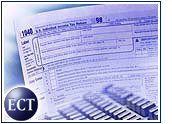
Although the number of electronic income tax returns filed through the first week of March in the U.S. rose 36 percent compared to last year, many more consumers are spurning online tax filing methods because they do not provide enough security, ease and versatility.
According to the U.S. Internal Revenue Service (IRS), more than 35 million people filed their taxes electronically last year, with 42 million expected to do so during the 2001 filing season.
However, research firm IDC has found that the vast majority of electronic returns continue to be filed by professional tax preparers, rather than individual at-home filers.
Buttressing this point, a report recently released by Jupiter Media Metrix found that 5 percent of U.S. taxpayers planned to use a do-it-yourself tax filing service on the Web (up from 4 percent last year).
“While do-it-yourself online tax prep is growing steadily, two-thirds of online users acknowledge they are reluctant to use these services for reasons such as security, privacy or reliability,” Jupiter senior analyst Rob Sterling said.
Insecurity Complex
Security and privacy concerns come with plenty of justification. In preparing a tax return online, an individual’s data files can sit on an Internet-exposed server for 24 hours a day, seven days a week — for weeks, according to published reports.
The General Accounting Office, the investigative arm of the U.S. Congress, reported in March that there were security lapses in the e-filing system during the 2000 tax filing season. Additionally, a programming glitch last year at H&R Block allowed about two dozen customers to read other people’s financial data online.
“You have a consumer acceptance issue in both privacy and security as well as reliability of the program and trust of its accuracy,” Yankee Group vice president of Internet strategies Kevin Noonan told the E-Commerce Times. “Even though [a return] may be secure getting there, it doesn’t mean the server won’t get hacked into later.”
No 10-4 on the 1040
Noonan said that beyond the security issue, the market for online filing is still generally limited to individuals with less complicated returns.
“For the more complicated filers, people would rather give it to someone or do it by hand, as opposed to throwing numbers into a box and just trusting it” Noonan said. “A lot of people worry about just throwing numbers in into a program and not seeing how it gets to the end result. They want to see the whole process.”
According to the Jupiter Media Metrix study, the average time spent at tax-related sites has increased 42 percent, from 22.6 minutes per person in February 2000 to 32.1 in February 2001.
The question is, do the lengthening visits signify that customers are increasingly confused or frustrated with the online tax sites?
2007 – A Tax Odyssey
In any case, Internet tax sites continue to show overall growth. Jupiter Media Metrix found that the number of unique visitors to tax sites increased to 16.4 million in February 2001, a 27 percent rise from the 12.9 million who visited in February 2000 (last year’s peak month).
However, Noonan said that the IRS has a long way to go to meet their goal of having 80 percent of all tax and information returns filed electronically by 2007.
“Maybe by 2007 they will have convinced me more,” Noonan said. “I don’t think they’ll actually be able to [reach that goal] because filing taxes is so personal and private, people still want to feel like they’re in control and understand the process.”
More Required
Sterling said that the future success of e-filing sites depends on their ability to secure and strengthen customer relationships by offering more than basic tax services.
“The greatest potential for Internet tax solutions will be their use as collaborative hubs, benefiting financial institutions, CPAs, financial planners and their business and consumer clients,” Sterling said.
Noonan added that, as with other e-commerce sectors, the future for tax preparation sites lies in the brick-and-clicks.
“These sites have to build brand awareness to build the trust up,” Noonan said. “If you look at e-banking, the industry still doesn’t have critical mass to the point that people trust it, but it’s growing because the bigger banks are coming on board. Tax filing sites need to brand the online channel with their brick channel, without a physical presence they don’t have a brand.”![]()













































Social Media
See all Social Media